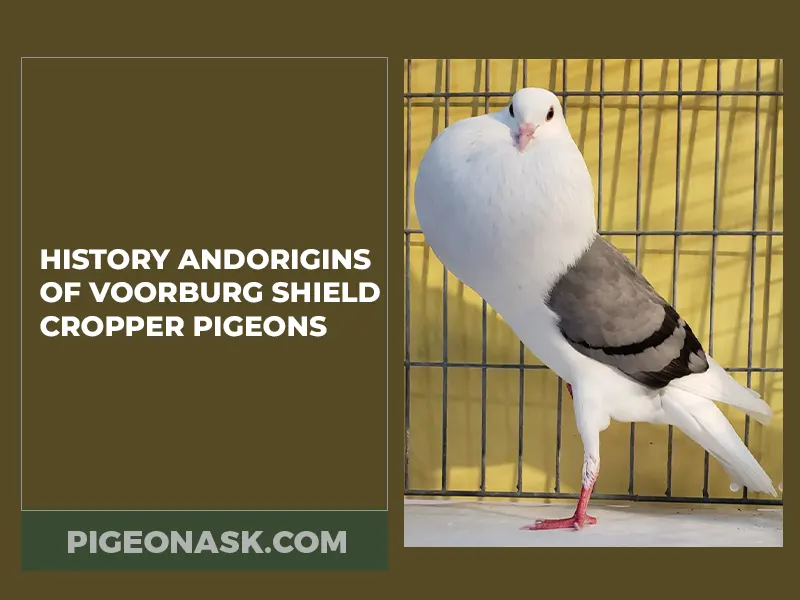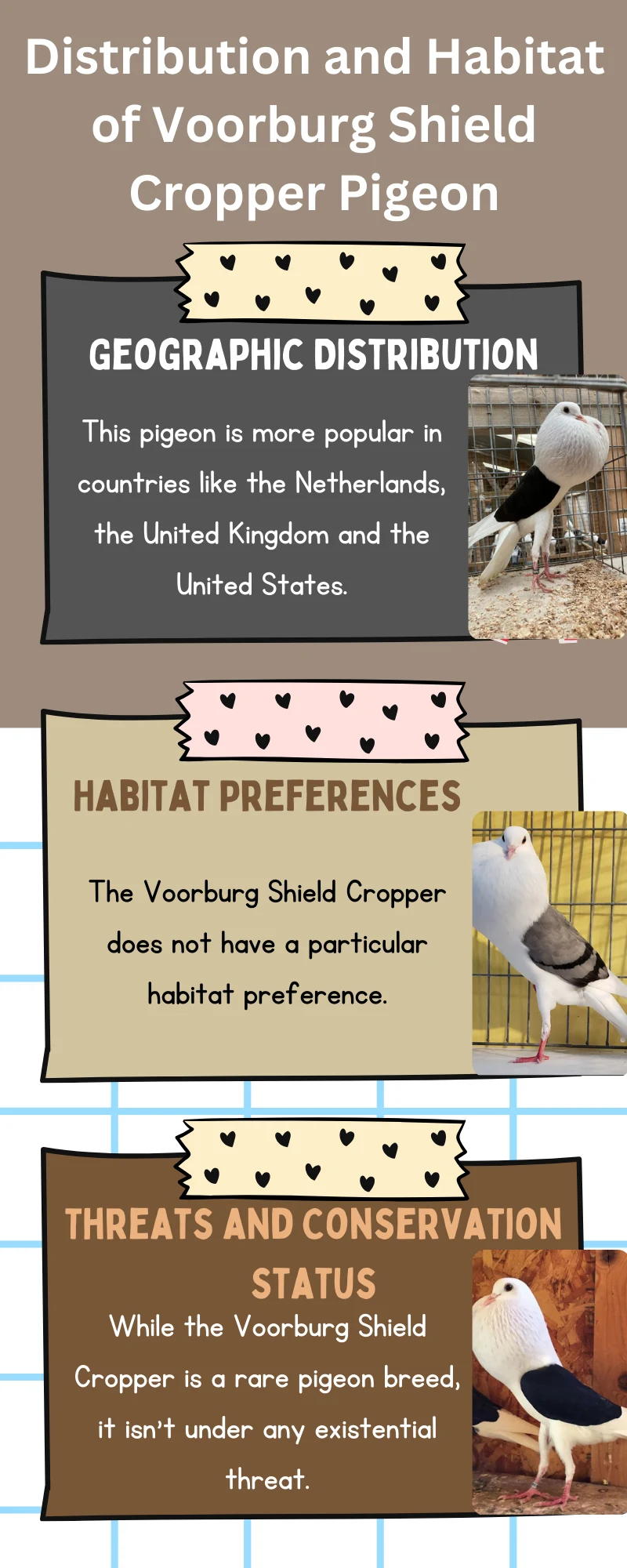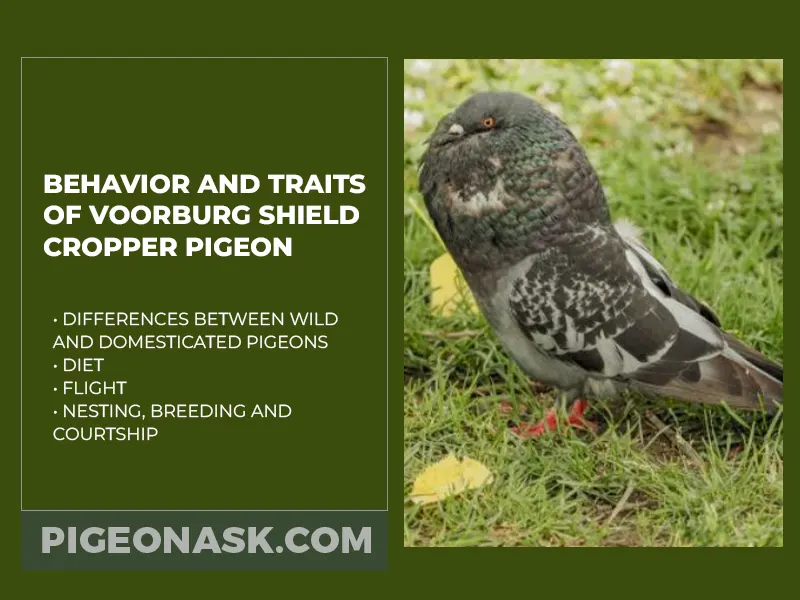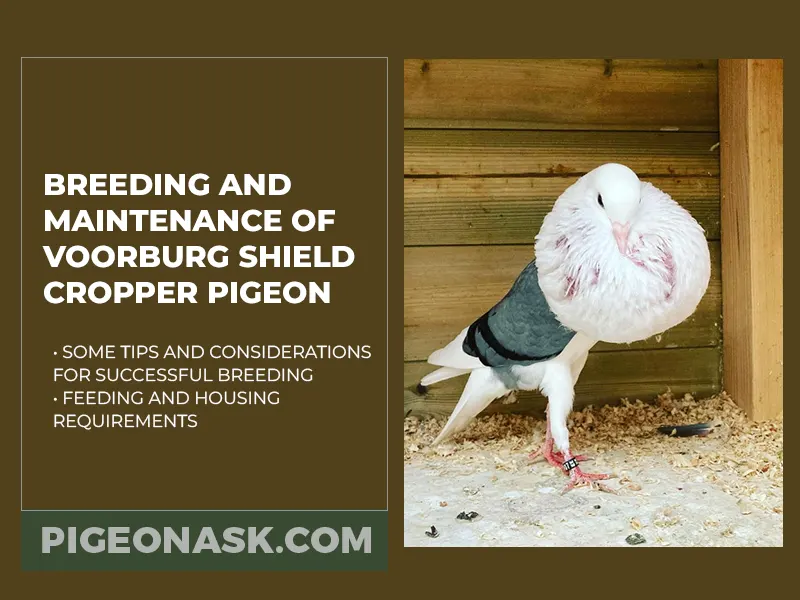Voorburg Shield Cropper Pigeon Breed
The Voorburg Shield Cropper pigeon is the pinnacle of selective breeding.
When you look at this bird, you look at a fancy and proud bird that took years to develop. If you’re a fancier or breeder, then this pigeon breed should definitely be on your list.
Fortunately, breeding the Voorburg Shield Cropper pigeon is easier now.
During this article, we will cover everything you need to know about this bird, like how to create the perfect mating conditions and how to raise them.

Don’t feel intimidated by this magnificent bird! Continue reading and find out how to create your own small flock.
Voorburg Shield Cropper Pigeon Profile
| Name | Voorburg Shield Cropper Pigeon |
|---|---|
| Scientific Name | Columba livia domestica |
| Common Names | None |
| Origin | Netherlands |
| Size | Medium |
| Weight | 300 to 370 grams |
| Lifespan | 7 to 10 years |
| Physical Features | Slim body build, small head, upright standing stance, long legs, globe in neck area |
| Temperament | Docile |
| Behavior | Calm |
| Special Features | Medium-sized globe |
| Breeding and Maintenance | Easy |
| Common or Popular Varieties | Different colors and patterns |
Interested in similar topics on pigeon breed:
Overview of Voorburg Shield Cropper Pigeons
The Voorburg Shield Cropper pigeon is a bird bred and raised for show purposes. Alternatively, this pigeon can serve as an ornament because of its fancy look.
You can even keep it as a pet due to its friendly behavior around humans.
History And Origins of Voorburg Shield Cropper Pigeons
Popular geneticist C.S.T. Van Gink first developed the Voorburg Cropper pigeon in the Netherlands during the 1929s. The goal was to breed White Croppers with colored breasts, which took years to accomplish.
Nonetheless, Mr. Van Gink finally succeeded after crossing the Norwich Cropper, Brunner, Steiger Cropper, English Cropper and Emperor Smierel Cropper, among other breeds.
Also, he employed crossbreeding techniques using the Schild pigeons to produce gorgeous markings and colors.

While this intense level of crossbreeding often produced off-colored offspring, the results were satisfying at last.
In 1938, the Council of Pigeon Experts accepted the Voorburg Shield Cropper pigeon as developed by Mr. Van Gink.
Very few breeders worked with the Voorburg Shield Cropper pigeon, which led to the creation of the Voorburg Shield Cropper club.
Unfortunately, this project ceased its activities in 1954.
It wasn’t until the 1960s when Mrs. H. van Gink-Porsgen resumed breeding this pigeon and increased its popularity.
Over time, the Voorburg Shield Cropper became an active member of exhibitions in Europe and the United States.
Physical Characteristics and Features
The Voorburg Shield Cropper is a bird with a unique appearance.

Here, we will describe the main features of this pigeon, which will help you identify them quickly.
| Name | Physical Characteristics |
|---|---|
| Head | Long, rounded perfectly with a slightly curved forehead |
| Eyes | Dark color, with a small, fine and pale cere |
| Beak | Straight, solid and medium size. Pale color |
| Neck | Long and slightly curved to the back |
| Globe | Medium size, rounded. It must raise from the waist and shoulders smoothly |
| Shoulders | Positioned high compared to the body, narrow and held close to the body |
| Breast | Long and narrow |
| Wings | Long compared to the body, held close to the body in a way that the pigeon carries parts of the side of the wings on the tail |
| Feathers | Smooth and tight to the body |
| Legs | Featherless and long |
| Weight | From 300 to 370 grams |
Unique Features
There are many unique features to the Voorburg Shield Cropper. Most notably, we must mention the globe this pigeon carries around its neck.
This feature is perhaps the most eye-catching feature of this bird and one of the reasons for their fanciness.
Some Common Variations
The Voorburg Shield Cropper is a very diverse pigeon featuring different colors and patterns. Have a look at the most common variations here.
| Variation | Description |
|---|---|
| Self In | Black, dun, red, yellow, mealy and cream. Additionally, blue with or without black bars, silver with or without dark bars and dilute brown. |
| Chequered In | Blue or dilute blue, brown or dilute brown, mealy and cream. |
| White-Laced In | Black, blue, red, yellow and brown. |
| White Bar In | Blue or dilute blue, black, brown, red and yellow. |
| Seamed | Black, red, blue, yellow and brown. |
Distribution And Habitat
What’s the most suitable habitat for Voorburg Shield Croppers?

Let’s analyze the common preferences of this bird to understand it a little better.
Geographic Distribution
As a universally recognized pigeon breed, the Voorburg Shield Cropper is a bird you can find in different countries on multiple continents.
Nonetheless, this pigeon is more popular in countries like the Netherlands, the United Kingdom and the United States.
Habitat Preferences
The Voorburg Shield Cropper does not have a particular habitat preference.
You can breed and raise these pigeons in rural, suburban, or urban habitats if there’s plenty of space available. Even if these pigeons are for exhibition, they still enjoy spacious areas to roam and socialize.
Threats and Conservation Status
While the Voorburg Shield Cropper is a rare pigeon breed, it isn’t under any existential threat.
Many farms around the world breed and raise this pigeon for sale, allowing you to get a mating pair and keep them for your projects.
Behavior And Traits of Voorburg Shield Cropper Pigeons
The personality of the Voorburg Shield Cropper is actually a crucial part of the breed standards.

As recommended by Van Gink himself, this pigeon breed must have an active, affectionate and lively nature. Otherwise, Voorburg Shield Croppers that don’t meet these demands will not satisfy the general breed standards.
Differences Between Wild and Domesticated Pigeons
Voorburg Shield Croppers are not suitable for the wilderness. This pigeon breed is domestic, meaning it needs the care and accommodations of an indoor habitat. In the wild, the breed is not likely to survive for long.
Diet
When you raise Voorburg Shield Croppers, you can help them grow healthy by feeding them traditional pigeon feed or pellet.
These products include cereal, grains and seeds, among other nutrients and vitamins necessary for pigeons and birds. Additionally, veggies, nuts and insects could be little treats to supplement this diet.
Flight
Voorburg Shield Croppers are moderate fliers. While these birds don’t usually take the skies, you will see them flying between perches.
Providing plenty of space to fly and features like perches could be handy to let the pigeons exercise.
Nesting, Breeding and Courtship
During the breeding season, you may notice interesting behaviors like the females flapping their wings. The males will also display courtship signs, which the female may accept.
After mating, it will take a couple of weeks for the hen to lay a couple of eggs. The parents will incubate these eggs for around 20 days until the chicks break the shell.
While the Voorburg Shield Cropper does not require complicated nests, you still have to provide materials like straw or hay. The parents will use them to make the nesting bowl comfortable.
Breeding And Maintenance
The Voorburg Shield Cropper lives peacefully and is not likely to create a chaotic environment in the loft. Therefore, maintenance may be necessary only once a week.

You can even make things easier by covering the floor with hay or wood to pick up waste more easily.
Some Tips and considerations for successful breeding
- Select the mating pair based on factors like type, crop, built and vitality. Additionally, choose hardy birds only to ensure the offspring are healthy.
- The Voorburg Shield Croppers are great parents, but you must check the eggs regularly to ensure they’re safe.
- Avoid grabbing the eggs to prevent disrupting the parenting bonding.
- Female Voorburg Shield Croppers can lay eggs again when the chicks are 14 days old.
- You can move the chicks to a separate cage when they’re over four weeks old.
- Likewise, adding a small container with water and little food is a good way to train the younglings.
Feeding and Housing Requirements
A pigeon aviary or loft is the ideal housing for this pigeon breed. In this building, the Voorburg Shield Cropper can walk around and flap their wings to exercise when they fly to perches.
Make sure the loft has plenty of ventilation and that the pigeons have plenty of space per bird.
Feeding
Feed your Voorburg Shield Croppers throughout the day by providing approximately one cup of feed per pigeon.
You can insert the food over an item with a flat surface, like a baking sheet or metal tray. Evaluate the amount of food provided and increase or lower the food based on whether the pigeons ate all of it or not.
Final Word
The Voorburg Shield Cropper pigeon is one of the most unique birds we’ve seen and we feel fascinated by it.
While working on this project, the history of this pigeon breed shows exactly how wonderful selective breeding can be.
The original breeder Van Gink had a vision of what he wanted and he worked hard and achieved exactly the pigeon he had envisioned.
And now, we have the Voorburg Shield Cropper as one of the pigeons with the most interesting physical features in the world.
But the Voorburg Shield Cropper isn’t the only breed that gets our attention. Follow us on Twitter, Facebook and Google News to see what other pigeon breeds we love and join us in our passion for birds!
